 Access Learning
Access Learning
The Future of L&D Report 2025: AI, Adaptation and the Skills Revolution
How human-centred learning and smart AI adoption will shape tomorrow’s workforce
For learning and development (L&D) teams, artificial intelligence (AI) presents both a major shift and a powerful opportunity. From personalised learning pathways to real-time skills analysis, AI is transforming how L&D is designed, delivered and measured, especially through the rise of intelligent digital learning solutions.
Access Learning’s inaugural Future of L&D Report 2025 brings together expert commentary from leading industry voices, alongside our own insights, to explore how L&D can evolve in step with this technological acceleration.
What does the future hold for L&D professionals? Will AI be a threat, an opportunity - or both? And in an era of expanding large language model (LLM) use, rising data demands and increasingly frequent cyber threats, how can L&D leaders ensure learning remains secure, ethical and impactful?
The report explores key challenges, forward-looking predictions, professional development trends and actionable takeaways for L&D teams working across small, medium and large UK businesses. It also offers a timely call to action: to embrace innovation without losing sight of what makes learning deeply human.
From content creation to strategic enablement
According to the experts, emerging trends in AI will shift L&D’s focus from content production to strategic performance enablement. Instead of creating high volumes of material, some useful, some less so, L&D will increasingly curate adaptive, high-impact learning experiences that drive actual behavioural change.
There will be less content, but it will have a much greater impact, according to the survey respondents. AI will allow us to shift from delivery to enablement. And in highly regulated markets such as financial services, caution also plays a huge role in strategy and how it feeds into compliance, as a number of new regulations come into effect in 2025.
Tom McDowell, of Evolve Learning Design, explained why regulated organisations are often nervous to make changes, and why steps should be taken cautiously, as opposed to rushing into making quick changes:
“In my experience, it’s often large, heavily regulated organisations, particularly in financial services, healthcare, and government sectors, that show the most hesitation. And it’s not because they’re anti-innovation. It’s because they’re risk-averse by design.
“When your L&D materials are subject to compliance review or carry legal weight, anything that smells like automation or black-box decision-making raises red flags. Add a few layers of sign-off and a data privacy policy last updated in 2009, and it’s easier to say “not yet” than to figure out how to say “yes”, safely.
While it’s important to tread carefully, secure AI with the right functions should be implemented sooner rather than later to avoid being left behind."
Elliot Gowans, general manager at Access Learning, said:
“Waiting too long poses a greater risk. Secure, well-governed AI tools can dramatically improve personalisation, efficiency, and learner engagement. Organisations that act now, with the right safeguards in place, will be far better positioned to futureproof their L&D strategy than those who delay and fall behind the curve.”
William Tincup, president of Recruiting Daily, said compliance should be prioritised into your AI strategy, as opposed to looking at it from the opposite perspective:
“Compliance is going to act like both a speed bump and a GPS. It’ll slow down reckless adoption but steer companies toward safer, smarter AI use cases. The laggards will treat it as an afterthought and get burned. Either way, AI vendors serving L&D will need to become compliance-first operators, not just tech providers. The smart players will bake compliance into their AI strategy from day one.”
This transformation hinges on the creation of smart, secure, dynamic eLearning ecosystems. Platforms like Access LMS Evo are already pointing the way - leveraging AI automation and performance-led insights to embed learning directly into the flow of work.
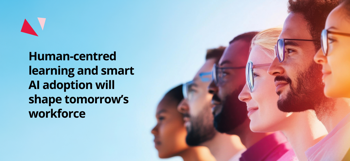
Learning that builds life skills, not just work skills
AI has the potential to supercharge learning, but only when used in service of human needs, and grounded by real insight. In a world flooded with generic AI-generated content, empathy, relevance and personalisation will distinguish impactful L&D.
Andy Lancaster, chief learning officer at Reimagine People Development, and public speaker, stresses the importance of what he calls “interpersonal skills, not soft skills” - like creativity, emotional intelligence and communication. These will become the foundation of effective workplace learning.
Lancaster emphasises that creativity, once thought of as an innate trait, is a teachable skill - and one that fuels innovation at the cutting edge. He also highlights the importance of L&D in supporting mental health and wellbeing, adding that “interpersonal skills” are vital for thriving in increasingly complex workplaces.
Sarah Mian, head of content at Access Learning, gave a clear warning around AI: if humans are removed from the design loop, the consequences go beyond poor UX - they threaten learning credibility itself.
“If you take people out of the equation, you don’t just risk inaccuracies - you create content that’s robotic, lifeless and unengaging. Learners can spot it a mile off,” she says. “Engagement has been one of L&D’s biggest challenges for years. AI won’t fix that unless it’s used with care.”
That’s where engaging, human-first eLearning courses play a vital role, in forming the heart of meaningful learning journeys that connect emotionally as well as intellectually. Designed to resonate with learners, these courses prioritise empathy, relevance, and trust from the very first interaction. Delivered seamlessly through platforms like Access LMS Evo, they’re supported by intelligent automation and structured pathways that ensure each journey is not only effective and efficient, but also deeply human at every step.
Our own Elliot Gowans agreed that emotional skills shouldn’t be underestimated:
“These are complex, deeply human skills that are challenging to teach and even harder to master - but they’re increasingly vital. As AI takes on more technical, administrative and repetitive tasks, the human skills that drive connection, creativity and critical thinking will become the true differentiators. L&D teams need to reframe their strategies to prioritise these areas - because if AI is augmenting the technical, then it’s our humanity that adds the real value.”
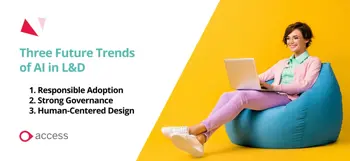
L&D’s own skills gap could become a bottleneck
To truly harness its potential, L&D professionals need to look inward and address their own evolving skills gap. They need to showcase to the rest of their team that they are aware of the changes and equipped to make them.
In a world where compliance and learning can be underprioritised by employees amid busy schedules, the L&D team need to be showcasing their own strengths and leading with intention. That means moving beyond traditional capabilities and embracing new, in-demand skills: prompt engineering, data literacy, critical thinking and AI tool evaluation. Internal investment for upskilling in these competencies is crucial to avoid stagnation, as otherwise, L&D could be the bottleneck, rather than the enabler of transformation.
It comes on the back of findings from the World Economic Forum’s Future of Jobs 2025 report, which highlights emerging trends and the growing importance of digital and data-driven competencies: advanced tech fluency, AI understanding, cybersecurity and real-time analytics.
Beyond technical know-how, mindset matters. Dani Johnson, principal analyst at RedThread Research, argues that agility and curiosity are now essential leadership traits within L&D.
“It’s less about knowing how to use the tools, and more about staying open to what’s possible,” she explains. “I spoke to a leader testing AI-generated images - and the tech evolved overnight. That kind of pace makes it impossible to ‘catch up’ in the traditional sense. Instead, we need to stay exploratory and think critically about where these tools can really add value.”
In practical terms, this can mean asking challenging questions to understand how you can develop, such as:
- When is AI the right solution - such as in personalised content delivery?
- When is human interaction irreplaceable, for example in collaboration, coaching, or emotional connection?
Respondents cautioned that while AI offers powerful efficiencies, it won’t solve everything. They highlighted the need to balance technological tools with human insight, and pointed to a common skills gap in data and analytics within L&D teams - a gap that must be addressed to build AI-literate, future-ready functions.
To lead others into the future of learning, L&D must first evolve itself. The next great transformation won’t be possible without it.
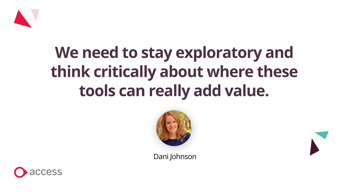
Critical thinking will still be the #1 learning priority
As AI automates more of the content creation process, the focus for learning shifts from information delivery to interpretation. Critical thinking, the ability to analyse, challenge, validate and contextualise information, has never been more essential, and almost every single expert cited critical thinking as an emerging trend and a huge priority as we go into the next era of learning and development.
Robin Hoyle, head of learning innovation at Huthwaite International, reinforces the urgency of this shift:
“In the age of AI, we don’t need learners to just know - we need them to think. With AI increasing in organisations, being able to focus on the data that really matters and potentially drives strategy and HR requirements will become more and more important. The reality, however, is that most people are really unskilled in selecting data and understanding what it tells them. You can’t ask an AI tool to analyse data – which it does very well – if you have no idea what the data may tell you and what constitutes robust and meaningful data in the first place.”
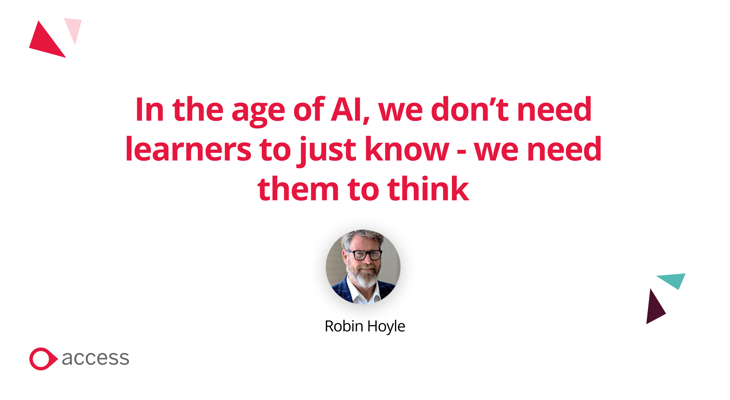
Learning platforms and tools have a powerful role to play in shaping deeper, more thoughtful learning experiences. When thoughtfully designed and delivered, eLearning content can go beyond knowledge transfer, it can embed critical thinking into every interaction, encouraging reflection, presenting diverse perspectives, and prompting learners to question, explore, and challenge ideas rather than passively absorb them.
William Tincup offers a stark but insightful reality check:
“Critical thinking is in freefall, and I say that with love. Everyone’s been spoon-fed frameworks and checklists, but the muscle of genuine problem-solving is atrophying. Also, anything related to data literacy - not hardcore data science, just the ability to make decisions with data. And let’s not forget leadership. Post-pandemic, a lot of leaders are struggling with managing hybrid teams, maintaining culture and coaching instead of commanding.”
This reflects a deeper concern: learners don’t just need content - they need capability. The goal is not efficiency alone, but empowerment.
Sarah Mian adds a human dimension to the issue:
“AI can feel robotic and impersonal. And as humans, we’re biologically wired to learn from each other. The minute something lacks that human spark or sense of personalisation, we disengage. That’s the danger - we could unintentionally design for disengagement while trying to scale learning.”
This is why critical thinking is the keystone. It underpins not only how we engage with AI, but how we lead, collaborate and adapt in the face of rapid change and emerging trends in workplace learning.
“We’re seeing an explosion in content, but not necessarily in comprehension,” said Andy Lancaster. “That’s why analytical and critical thinking - though often seen as ‘generic’ skills - are now vital. Whether it's for problem solving or decision making, learners need to make smart, discerning calls in a high-noise environment.”
Laura Overton, co-creator at Learning Changemakers, underscores this broader perspective:
“Even in early-stage research, I’ve seen how focusing solely on tech risks missing the point. The real opportunity lies in how AI is applied to change behaviour - not just improve content or efficiency.”
As AI raises the floor of what’s possible, critical thinking raises the ceiling of what’s meaningful. It’s the muscle L&D can’t afford to let wither.

“Just-in-time” microlearning will become crucial
Microlearning has long been part of the L&D conversation, but until now, it often lacked true contextual power. With AI, that’s changing, and fast. What once felt like a one-size-fits-all format is becoming sharply tailored, highly engaging, and effortlessly integrated into the flow of work.
“We’ve been talking about microlearning for a decade - it’s a bit old hat,” said Sarah Mian. “But what AI enables is truly contextual, just-in-time microlearning - bite-sized pieces of learning that solve a problem in the moment, specific to your role, your goals, or your skills gaps.”
Relevancy in learning and development is the game-changer. Not just because it's efficient, but because it fuels engagement at a neurological level. It’s about hyper relevancy, as the more relevant content is, the better engaged learners will be. If AI can personalise learning to someone’s intrinsic motivation, in particular for younger employees, you’ll see real traction.
The challenge has always been in keeping people engaged, and modern AI-powered learning management systems enable learning to happen through natural, human-like interaction - no more clicking through clunky interfaces or hunting for training modules.
“Now we can talk to our systems. We can ask for what we need, and get it - instantly. If it’s not quite right, we refine the conversation. It’s intuitive, it’s natural, and it mirrors how we learn best: through dialogue,” said Mian. “AI is making scenario-based learning easier to implement and more engaging. Those interactive choice points light up our neurons - they trigger real engagement and better retention. And now, it’s no longer burdensome to create.”
Beyond content delivery, AI is enhancing learning design itself. Scenario-based learning - once time-consuming to produce - is becoming scalable and interactive, unlocking immersive "choose-your-own-adventure" learning journeys.
In short, AI isn’t just streamlining microlearning - it’s supercharging it. By enabling personalised, conversational, and scenario-rich experiences, it’s turning every learning moment into a meaningful, measurable opportunity.
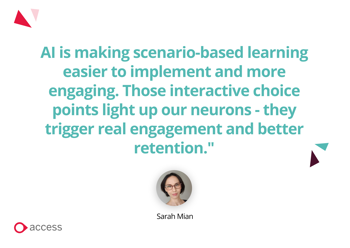
Cybersecurity fears will reshape how we design learning
Along with the emerging trend of learning professionals harnessing AI to personalise, scale and streamline development, they’re also becoming stewards of increasingly sensitive data. From performance metrics to behavioural insights, the data being captured and analysed is vast - and valuable.
“Learning professionals have often seen data privacy as a compliance box to tick,” said Andy Lancaster. “But we’re now shifting toward embedding privacy and security as core design principles. This isn’t just about ‘what we have to do’ - it’s about how we responsibly create learning from the ground up.”
Traditional training, like avoiding suspicious links or USB sticks, is no longer sufficient. As AI tools evolve, so must our security strategies. Respondents stressed that AI adoption without robust safeguards is a serious risk, highlighting the need for tighter data access controls, awareness of where data is stored (and its legal implications), and the potential of private cloud solutions to strengthen protection.
This sentiment is echoed across the industry. AI systems that fail to guarantee data security - or lack transparency - will quickly lose trust.
“Data privacy is going to go from background noise to front-page crisis,” said William Tincup. “We’re entering an era of employee surveillance paranoia, and rightly so. People will ask: Who sees my data? Is my learning history being weaponised? Companies without clear answers will lose both trust and talent.”
Tincup also warns of a crackdown on shadow AI use:
“Expect stricter vetting, sandboxing, and even bans on third-party tools until they meet enterprise-grade security standards. IT teams will demand provenance, asking questions such as: Where was this model trained? Who has access? The era of ‘shadow AI’ is over. Either it’s secured or it’s shut down.”
Elliot Gowans echoed the statements, saying how much we need to ensure the responsible and ethical deployment of AI in learning, and uphold ethical practices for the industry’s reputation.
“At a time when fears around data misuse and cyber attacks are very real. Those in decision-making roles need to ask challenging questions around where data is stored, who has access, and how it’s protected. We must collaborate much more closely with data analysts, engineers, legal and compliance teams - and crucially, with cyber security and privacy experts. Just look at the recent breach at the Legal Aid Agency - trust can be fragile. That’s why closed-circuit AI offerings that safeguard data are so important, to ensure data never leaves the organisation’s control.”
Good governance will be the line between trusted AI and organisational risk
In the race to adopt AI, governance is the guardrail. Without it, organisations risk not only data breaches but employee mistrust and reputational damage.
“Those who face into the reality of AI and govern it sensibly will be far better placed to support data privacy,” said Michelle Parry-Slater, L&D director at Kairos Modern Learning. “Just as companies once blocked YouTube - only to see staff turn to their phones for learning - AI will go underground if leaders don’t tackle it head-on.”
Nowhere is this pressure more intense than in highly regulated sectors like financial services, where teams are constantly adapting to new compliance rules, audit trails and evolving governance standards. In these environments, the margin for error is slim - and the expectation for secure, ethical AI use is high.
As financial institutions face increasing regulatory scrutiny, AI governance can no longer be an afterthought. Responsible deployment, transparent data practices and proactive risk management are now essential.
The next phase of AI-powered learning isn’t just about what’s possible - it’s about what’s permissible, secure and ethical. Businesses need to showcase trust, transparency and governance.
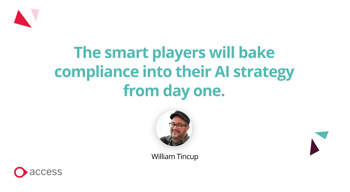
AI could unlock a new era of accessibility in L&D
AI holds transformative potential for making learning truly inclusive - but it’s a frontier that’s still underexplored. As the EU Accessibility Act (EAA), a landmark EU law that mandates minimum accessibility standards, including digital products and services, comes into effect in June 2025, businesses will need to train staff on how to ensure they’re meeting the right standards.
“Accessibility has always been a priority for us at Access,” said Sarah Mian. “But we’re still searching for that ‘golden ticket’ - where AI enables truly personalised, accessible learning experiences for everyone. Under the umbrella of disability, there are so many different needs. What works for someone with dyslexia might not work for someone with autism or another learning difference. If AI could automatically adapt content formats to suit individual needs, that would be a game changer.”
One current trend in the industry where AI is already proving its value is in language translation. Real-time, on-the-fly translations are helping organisations scale their learning content to global teams - removing language as a barrier to engagement.
AI’s growing role in content curation is another accessibility win, helping surface the right content for the right person at the right time.
Still, Mian believes we’re just scratching the surface:
“We’re beginning to catch up, but AI’s potential to support accessibility is still vastly underutilised.”
So what next?
Elliot Gowans, said:
“One of the most dangerous phrases in any organisation is: ‘We’ve always done it this way.’ In learning and development, that mindset is a major barrier to progress. It’s not just about resisting new tools or platforms - it’s about outdated thinking. L&D has a critical role to play in challenging the status quo. In fast-moving environments, where the pace of work is accelerating and skills needs are shifting, learning strategies must evolve too. Clinging to legacy approaches won’t prepare people for the future - it holds them back.”
AI is reshaping professional development trends and the future of L&D - not just accelerating what’s possible, but raising the bar for personalisation, engagement and impact.
But transformation won’t come from speed alone. Responsible adoption, strong governance and human-centred design are the future trends that will separate the innovators from the risk-takers.
Solutions like Access LMS Evo are already leading the way. With secure, AI-powered features that support microlearning, personalisation and compliance, they help L&D teams create adaptive, high-impact learning experiences - safely and at scale.
The opportunity is clear: to use AI not just to deliver more content, but to build smarter, safer, more effective learning ecosystems.
Thank you to our survey respondents:
People surveyed include:
Sarah Mian, Access Learning, The Access Group
Andy Lancaster, Reimagine People Development
Laura Overton, co-creator at Learning Changemakers
Dani Johnson, RedThread Research
William Tincup, Recruiting Daily
Michelle Parry-Slater, Kairos Modern Learning
Robin Hoyle, Huthwaite International
Tom McDowall, Evolve Learning Design
Elliot Gowans, Access Learning, The Access Group
Boost engagement with our learning solutions
Our suite of digital learning solutions has everything you need to build a thriving learning culture. Combining a learning management system, engaging eLearning content, and a learner-centric upskilling tool, we empower organisations to deliver impactful and scalable learning experiences.

 AU & NZ
AU & NZ
 SG
SG
 MY
MY
 US
US
 IE
IE









